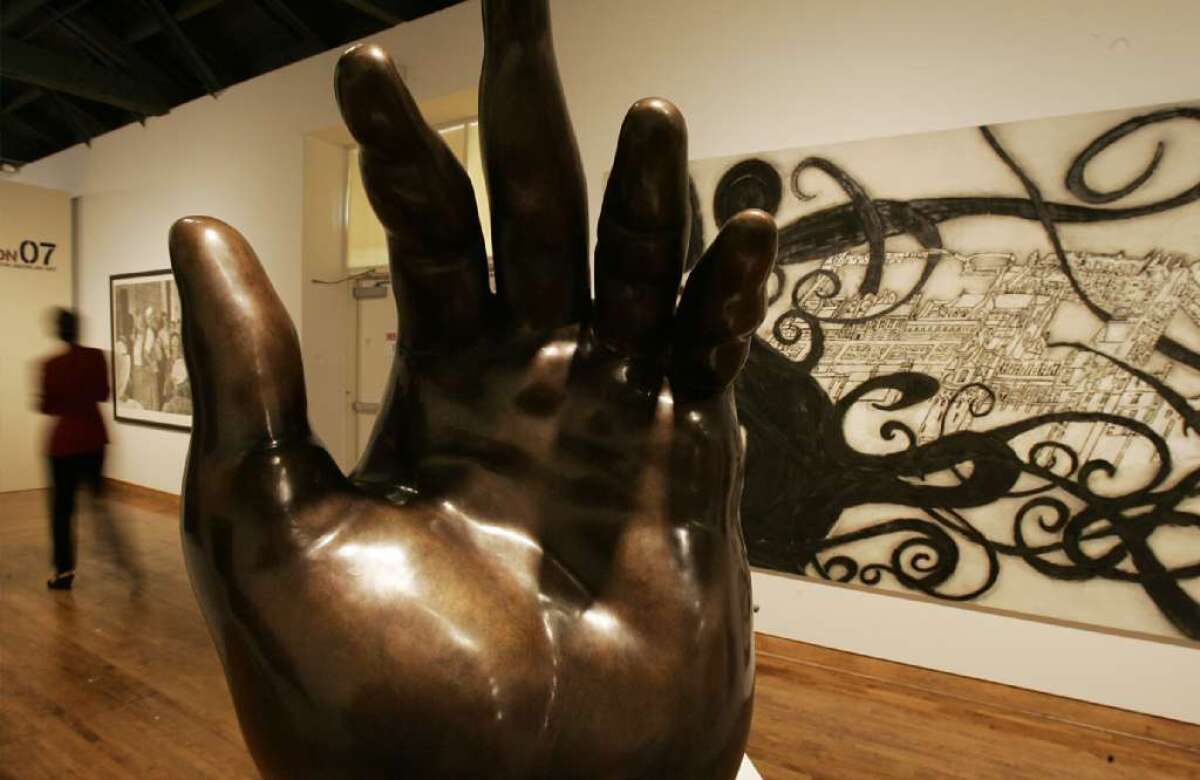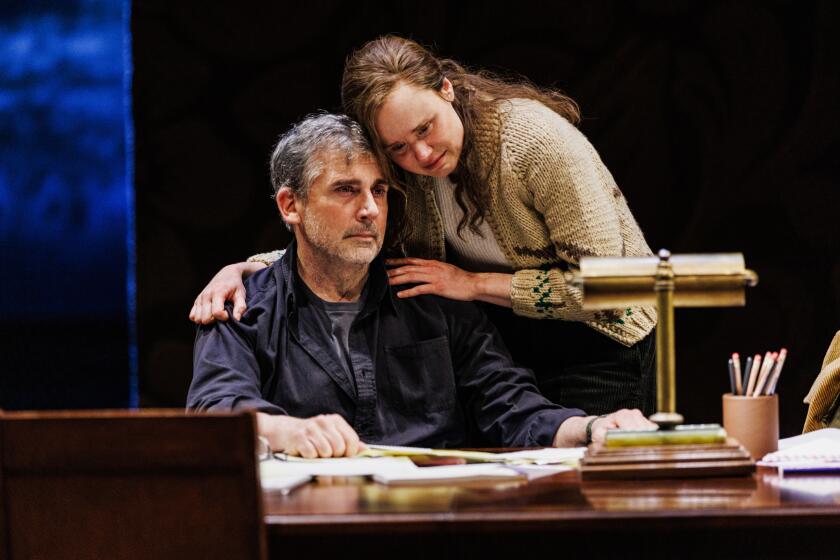Museum of Latin American Art defends auctioning dozens of works from its collection

The Museum of Latin American Art, which put 59 artworks from its permanent collection on the auction block last weekend, defended the move Thursday as an attempt to diversify its holdings.
The works joined other objects donated to the museum by supporters specifically for the online auction, which consisted of 140 paintings, sculptures, prints, drawings and photographs. The sale, on the e-commerce site Invaluable, raised about $200,000 for MoLAA, less than half the high auction estimate of $474,000.
For the record:
11:33 a.m. Dec. 11, 2020An earlier version of this post said the Palm Springs Art Museum is in Florida. It is in California.
The deaccessioning of artworks from a museum’s permanent collection is widely and deeply frowned upon. Times critic Christopher Knight called MoLAA’s mass unloading of work by artists from Central and South America, Cuba, Mexico and the United States “a virtual fire sale of art” that was an “unprecedented bulk-removal of works from the museum’s collection.”
MoLAA’s collection consisted of 1,333 objects, so the auction — at which 44 of the 59 key works actually sold — amounted to a reduction of about 3.3%.
Chief curator Gabriela Urtiaga canceled a phone interview Wednesday and answered questions from The Times only by email. She stressed that, even though MoLAA entered the COVID-19 pandemic with a financial deficit and has been closed since March, the sale was not a response to economic hardship but part of a long-term initiative to diversify the collection, making it stronger, more relevant and balanced.
Eighty percent of the works in the collection are by male artists, she said, so the goal is to acquire work by female artists; modern and contemporary work by Latin American, Chicanx and Latinx artists; and more pieces by emerging artists. Certain individual artists, she said, were “overrepresented” in the collection.
“MoLAA has a responsibility in terms of representation of Latin American and Latinx art,” Urtiaga said. Over the last two years, she said, MoLAA has acquired “important artworks of Chicanx artists including Frank Romero, Patssi Valdez, Yolanda Gonzalez, Carlos Almaraz and Gilbert Luján, to name a few, and Latin American artists like the artistic duo Chiachio & Giannone, among others.”
When The Times noted that four of the six were male artists, Urtiaga said those acquisitions were made before she joined the museum in September 2019. All 44 works from the permanent collection that sold Sunday were by male artists.
“Diversifying the collection is a complex process and there are many different issues with respect to identity to contend with,” Urtiaga said. “Diversifying the collection has meant shifting away from our previous focus on only Latin American work, and moving towards creating a collection that is reflective of Latinx and Chicanx [artists] in the U.S., irrespective of gender. However, acquiring works by Chicanx and Latinx women is the museum’s priority moving forward.”
Urtiaga said MoLAA followed the American Alliance of Museums’ and the Assn. of Art Museum Directors’ deaccessioning guidelines, which specify that sale funds must go toward new acquisitions, although the directors association this spring loosened its restrictions for two years, to give financially struggling museums a lifeline during the pandemic. The museum alliance’s guidelines say such funds can also go toward direct care of the collection.
“All the money for the deaccessioned works will be assigned to a restricted account dedicated to the acquisition of other remarkable artworks for our collection,” Urtiaga said.
On MoLAA’s bucket list: work by Los Angeles artist Judy Baca, Brazilian painter Tarsila do Amaral, Cuban American artist Ana Mendieta and Colombian artist Beatriz González. Also on Urtiaga’s list: Frida Kahlo, whose “Portrait of a Lady in White” fetched more than $5.8 million at Christie’s last year.
When asked how the museum planned to acquire work by artists who command such high prices, Urtiaga said, “We don’t have specific plans to acquire works by Frida Kahlo in the short term.”
MoLAA, which possessed four artworks by Mexican American Neo-Surrealist Ray Smith, kept one painting and two mixed-media works but sent another mixed-media work to auction. The three-panel “Los Espectadores” (1986) was estimated at $10,000 to $20,000 and sold for $4,250. The museum said this week that the funds will go toward acquiring different works by the same artist.
Urtiaga said the museum had too many mixed-media works by Smith. “When we speak about diversifying and balancing the collection, we’re not only talking about matters of identity but also of technique and medium,” she said.
When The Times wrote about the deaccession plan before the auction, a report on the museum’s website cited a 2019 budget deficit of $340,617. Museum representative Solimar Salas said that figure was out of date and that MoLAA had a deficit of $110,132 against a $3.7 million annual operating budget as of Dec. 31, 2019. She added that despite the pandemic, the museum is now in the black.
Salas said that in addition to a loan from the federal Paycheck Protection Program and COVID relief funds from the city of Long Beach, grants from the Kenneth T. and Eileen L. Norris Foundation, the Dwight Stuart Youth Fund, Southern California Edison and others have been secured.
Membership has plummeted: 1,060 members generated $88,547 last year, versus 752 members who have brought in $52,000 so far this year. But donor support has been strong, Salas said. The annual gala fundraiser, which raised $298,000 last year, was canceled, but online fundraising for 2020 has hit $80,000, compared with $10,000 last year, Salas said.
MoLAA, whose endowment stands at $24 million, held another online auction this summer, raising $68,000. It sold 168 works by Latin American and Latino artists, all donated from artists and collectors so the permanent collection did not take a hit.
The 59 items from the permanent collection put up for auction last weekend included works by such renowned artists as Mexicans Rafael Coronel and Rodolfo Morales, Brazilian Walter Goldfarb, Cuban Wifredo Lam and Chilean Roberto Matta.
MoLAA held the auction on the Boston-based e-commerce site Invaluable, which is not a traditional auction house but a self-described online marketplace for fine art, antiques and collectibles. Invaluable does not take possession of works to photograph, research, catalog and appraise the way a traditional auction house would. Clients such as MoLAA typically team up with an independent auctioneer or auction house to appraise the work and guide them through the sale. MoLAA worked with Alex Slato, a specialist in Latinx and Latin American art, who chose Invaluable for the auction. He appraised the works and managed the Sunday sale.
Invaluable’s executive vice president of marketing, Neal Glazier, said it was unusual for a museum to sell work on its site and, as it has done before with the rare nonprofit client, waived its listings fee and 5% commission (per sale) for MoLAA.
“This is not something we normally do,” Glazier said of the MoLAA sale. “There are not any other museums I am aware of deaccessioning on Invaluable, although it would be possible through an auction house using our platform.”
It’s far more typical for museums to sell work at established auction houses such as Sotheby’s or Christie’s.
The Everson Museum of Art in Syracuse, N.Y., sold an important Jackson Pollock drip painting for $12 million in early October at Christie’s. Later that month, the Palm Springs Art Museum sold a Helen Frankenthaler painting for $3.9 million at Sotheby’s.
The Baltimore Museum of Art recently put three important paintings by Andy Warhol, Brice Marden and Clyfford Still on the auction block. It suffered widespread criticism and reversed its plans just hours before the sale.
The museum world has been devastated by the COVID-19 health crisis. A recent American Alliance of Museums survey of 850 directors found that nearly 30% of museums in the U.S. were concerned about permanent closures if they were unable to obtain additional financial relief in the next 12 months.
When philanthropist Dr. Robert Gumbiner founded MoLAA, the museum was collecting and exhibiting artists only from Latin American countries, not Americans of Latin American descent. Since 2014, it’s vastly expanded that vision, Urtiaga said.
“The museum is a living and breathing institution, adapting to its contemporary time,” Urtiaga said, “and its mission is, in part, to represent the largest ethnic group in the United States.”
More to Read
The biggest entertainment stories
Get our big stories about Hollywood, film, television, music, arts, culture and more right in your inbox as soon as they publish.
You may occasionally receive promotional content from the Los Angeles Times.






